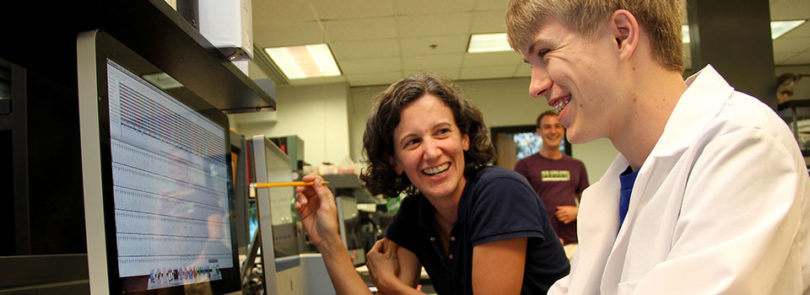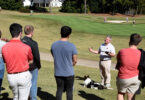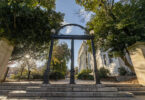After a few weeks of working with University of Georgia doctoral student Aimee Kowalski, Monisha Narayanan can now pipette like a pro. Besides mastering the art of getting drops of liquid into tiny plastic containers, the rising high school senior from Johns Creek has watched zebrafish grow from microscopic to swimming.
Narayanan is one of 44 high school students on the UGA campus this summer conducting research through the Young Dawgs program. Run by UGA Human Resources, Young Dawgs is doing more than capturing the imaginations of high school students and preparing them for future careers. It’s also partnering with local school districts and earning awards on the national level. The program recently received the 2013 Community Service and Outreach Award from the College and University Professional Association for Human Resources, a recognition that came with a $10,000 award.
“The award just shows UGA’s culture of service,” said Young Dawgs Director Jim Geiser. “I’m amazed at the commitment of the faculty and staff here. To me, that’s where the recognition is.”
The College and University Professional Association for Human Resources’ award recognizes the efforts of institutions to engage their employees through community service and outreach. The Young Dawgs program accomplishes this each semester by having students come to campus to intern with UGA faculty and staff in fields ranging from early childhood education to genetics.
The summer, though, is dedicated to science.
“All of these students are being exposed to the application of science,” Geiser said. “Often high schools teach science, but they don’t produce scientists. We’re helping turn students interested in science into real scientists. The program is pretty life changing for a lot of these kids.”
High school students spend six weeks studying areas such as chemistry, pharmacy, genetics, astronomy, physics and cellular biology. They work with professors conducting research on various topics including cancer, muscular dystrophy, erosion, ecosystems and moths.
Narayanan is working with Kowalski in UGA associate professor Scott Dougan’s cellular biology lab, which studies the molecular and cellular basis of pattern formation in vertebrate embryos and uses zebrafish as its lab model. She most enjoys “the fact that everything’s hands on, and I get to experience everything for myself,” she said.
She wants to be a pediatric cardiologist who both works with patients and conducts research. “It’s more interesting,” she said. “You never know where research is going to take you.”
The program serves about 110 students per year over three semesters. Since its inception in 2008, it has had close to 600 high school interns who have collected just more than 60,000 internship hours under the supervision and mentorship of about 600 volunteer UGA faculty, staff and graduate students.
Besides connecting students with faculty, the program also works with local businesses and organizations to link students in areas not available through the university alone.
Andrew Gallagher’s summer has been full of fruit flies and DNA. The rising junior, who lives on the line between south Forsyth and north Fulton counties, is interning with assistant professor Kelly Dyer in her genetics lab.
“Working in a UGA lab is very much different than what high school is like,” he said. “It’s a whole new world.”
Dyer, who has had Young Dawg interns for three years, enjoys showing students what lab life is really about.
“It gives them a taste of the different things we do, and an idea of both the ups and downs of research,” she said. “A research lab is very much a community of people. Science is very much a social experience, a social endeavor. Sometimes people don’t realize that.”
Her lab studies how organisms adapt to their environment using fruit flies as the study model. This summer, Gallagher is learning how to crush fruit flies to extract and amplify their DNA, and then to compare DNA sequences from different fruit fly species.
“These kids are seeing little pieces of science,” Geiser said, “and seeing how it fits into the application of life.”






